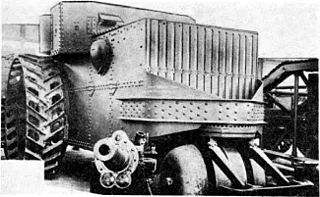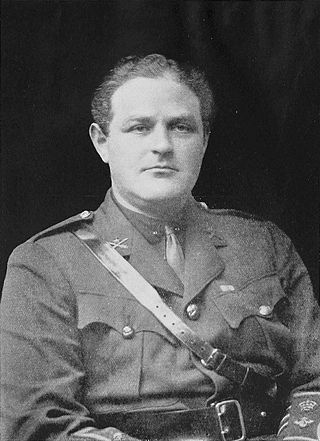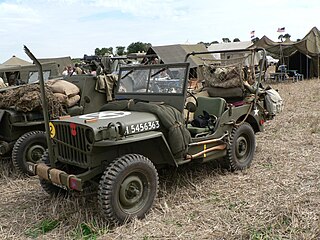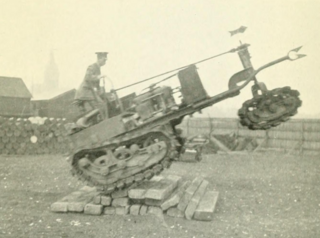
A tank is an armoured fighting vehicle intended as a primary offensive weapon in front-line ground combat. Tank designs are a balance of heavy firepower, strong armour, and good battlefield mobility provided by tracks and a powerful engine; usually their main armament is mounted in a turret. They are a mainstay of modern 20th and 21st century ground forces and a key part of combined arms combat.

The history of the tank begins with World War I, when armoured all-terrain fighting vehicles were introduced as a response to the problems of trench warfare, ushering in a new era of mechanized warfare. Though initially crude and unreliable, tanks eventually became a mainstay of ground armies. By World War II, tank design had advanced significantly, and tanks were used in quantity in all land theatres of the war. The Cold War saw the rise of modern tank doctrine and the rise of the general-purpose main battle tank. The tank still provides the backbone to land combat operations in the 21st century.

The Landship Committee was a small British committee formed during the First World War to develop armoured fighting vehicles for use on the Western Front. The eventual outcome was the creation of what is now called the tank. Established in February 1915 by First Lord of the Admiralty Winston Churchill, the Committee was composed mainly of naval officers, politicians and engineers. It was chaired by Eustace Tennyson d’Eyncourt, Director of Naval Construction at the Admiralty. For secrecy, by December 1915 the name was changed to "the D.N.C.'s Committee" to disguise its purpose.

British heavy tanks were a series of related armoured fighting vehicles developed by the UK during the First World War. The Mark I was the world's first tank, a tracked, armed, and armoured vehicle, to enter combat. The name "tank" was initially a code name to maintain secrecy and disguise its true purpose. The tank was developed in 1915 to break the stalemate of trench warfare. It could survive the machine gun and small-arms fire in "no man's land", travel over difficult terrain, crush barbed wire, and cross trenches to assault fortified enemy positions with powerful armament. Tanks also carried supplies and troops.

The development of tanks in World War I was a response to the stalemate that developed on the Western Front. Although vehicles that incorporated the basic principles of the tank had been projected in the decade or so before the War, it was the alarmingly heavy casualties of the start of its trench warfare that stimulated development. Research took place in both Great Britain and France, with Germany only belatedly following the Allies' lead.

Little Willie was a prototype in the development of the British Mark I tank. Constructed in the autumn of 1915 at the behest of the Landship Committee, it was the first completed tank prototype in history. Little Willie is the oldest surviving individual tank, and is preserved as one of the most famous pieces in the collection of The Tank Museum, Bovington, England.

The Lanchester armoured car was a British armoured car built on the chassis of the Lanchester "Sporting Forty", it saw wide service with the Royal Naval Air Service and British Army during the First World War. The Lanchester was the second most numerous World War I armoured car in British service after the Rolls-Royce armoured car.

Major-General Sir Ernest Dunlop Swinton, was a British Army officer who played a part in the development and adoption of the tank during the First World War. He was also a war correspondent and author of several short stories on military themes. He is credited, along with fellow officer Lieutenant-Colonel Walter Dally Jones, with having initiated the use of the word "tank" as a code-name for the first tracked, armoured fighting vehicles.

The Steam Wheel Tank was a U.S.-produced, prototype armoured fighting vehicle built by the Holt Manufacturing Company. Developed sometime between late 1916 and early 1917, it was the third tank to be designed in the U.S. The prototype was completed in February 1918 and was evaluated between March and May 1918 at Aberdeen Proving Ground. It performed poorly and was not developed further.

Sir Albert Gerald Stern was a banker who became the Secretary of the Landship Committee during World War I, where his organisational ability assisted the Committee in creating the first British tank.

Cultivator No. 6 was the code name of a military trench-digging machine developed by the British Royal Navy at the beginning of World War II. The machine was originally known as White Rabbit Number Six; this code name was never officially recognised, but it was said to be derived from Churchill's metaphorical ability to pull ideas out of a hat. The codename was changed to the less suggestive Cultivator Number Six to conceal its identity. The name was later changed to N.L.E. Tractors. Winston Churchill sometimes referred to the machine as his mole and the prototype machine was dubbed Nellie. It was lightly armoured and carried no weapons. It was designed to advance upon an enemy position largely below ground level in a trench that it was itself excavating. On reaching the enemy's front line, it would serve as a ramp for the troops and possibly tanks following in its trench.

The Breton-Prétot machine was an experimental wire-cutting device developed in France from November 1914. It was developed by Mr. Prétot, engineer, and Jules-Louis Breton, member of the French National Assembly.

The Souain experiment was a French military experiment using a Baby Holt Caterpillar, on the former battlefield of Souain, in northeastern France, on 9 December 1915. The experiment was a decisive influence on the French tank programme and initiated the design and order of the two French operational tanks, the Saint-Chamond and Schneider CA1.

A wire catcher is a device used to protect military personnel in open vehicles against taut-wire traps.

Killen-Strait was an American engineering company.

The Delaunay-Belleville armoured car was a British armoured car built on the chassis of the luxury French Delaunay-Belleville tourer. It saw service with the Royal Naval Air Service in the early years of the First World War.

The Pedrail Machine was an experimental British armoured fighting vehicle of the First World War. It was intended initially to be used as an armoured personnel carrier on the Western Front, but the idea was dropped in favour of other projects. Work on the machine was re-directed so that it could be used as the basis of a mobile flamethrower, but it was never completed and saw no action.

Group Captain Thomas Gerard Hetherington CBE was a British officer who served in the British Army, Royal Navy and Royal Air Force. He was one of those credited with the initial development of the tank during the early part of the First World War. Although his design for an enormous wheeled vehicle proved to be impractical, it earned him a seat on the Landship Committee and he participated in early experiments with tracked vehicles.

The Talbot armoured car was a British armoured car built on the chassis of a Clément-Talbot tourer. Built in small numbers to several patterns, the Talbot armoured cars saw service with the Royal Naval Air Service (R.N.A.S.) in the early years of the First World War, serving alongside Rolls-Royce and Delaunay-Belleville armoured cars.



















